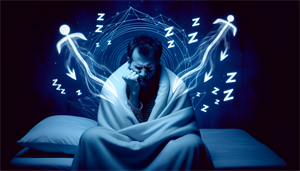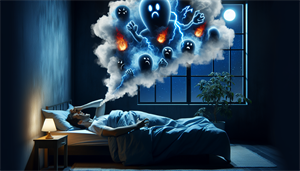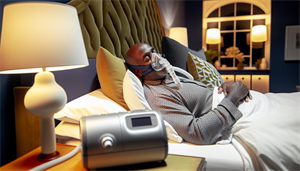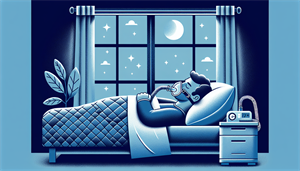Chronic pain and sleep apnea - two conditions that are challenging enough on their own. But what happens when they coexist? For many individuals, this is not a hypothetical question but a daily reality.
The intricate relationship between chronic pain and sleep apnea is much more than just the mere coexistence of two conditions - it’s a complex interplay that can significantly impact the quality of life.
As we delve into this topic, we’ll explore the ways these conditions interact, the challenges they present, and the potential strategies to manage them better, including the question: can chronic pain cause sleep apnea?
Key Takeaways
-
Chronic pain and sleep apnea have a bidirectional relationship, where each condition can exacerbate the other, suggesting the importance of early screening and dual-focus treatment strategies for patients experiencing both.
-
The prevalence of chronic pain is higher among patients with obstructive sleep apnea compared to the general population, and a range of chronic pain conditions, including fibromyalgia and arthritis, are closely associated with sleep apnea, highlighting the need for comprehensive and integrated management approaches.
-
Treatment strategies, including CPAP therapy, pain management techniques, and lifestyle modifications, can significantly improve the quality of life for individuals suffering from both chronic pain and sleep apnea and require careful consideration and customization from healthcare providers.
Understanding the Relationship Between Chronic Pain and Sleep Apnea

Decoding the link between chronic pain and sleep apnea is complex. To fully comprehend this intricate connection, one must first acknowledge the high prevalence of sleep disorders, particularly sleep apnea, among patients with chronic pain. Indeed, the prevalence of chronic pain among patients diagnosed with obstructive sleep apnea syndrome ranges between 51-76%. This is notably higher in comparison to the general population, where it ranges between 15-29%.
A closer look at this relationship reveals the impact of sleep disturbances on chronic pain. Sleep fragmentation and mood disorders play a significant role in exacerbating chronic pain in patients with obstructive sleep apnea. This highlights the intricate connection between sleep disturbances and chronic pain. However, the relationship isn’t one-sided. Chronic pain can also contribute to the development of sleep disorders, signaling a bidirectional relationship between these conditions.
Comprehending this association is pivotal for the efficient management of these conditions. Early screening and treatment of obstructive sleep apnea can enhance pain symptoms in patients with chronic pain. Thus, targeted treatments considering both conditions could potentially enhance the quality of life for patients suffering from chronic pain and sleep apnea.
The Bidirectional Nature of Pain and Sleep Disorders
The reciprocal interplay of pain and sleep disorders illustrates how chronic widespread musculoskeletal pain can lead to sleep disorders and how the latter can exacerbate pain. This cycle of exacerbating symptoms can present a significant challenge for individuals dealing with both conditions.
Consider the impact of obstructive sleep apnea on pain sensitivity. Individuals diagnosed with OSA demonstrate a reduction in pain threshold and an elevation in pain sensitivity and spontaneous pain compared to individuals without OSA. This highlights the connection between pain and sleep disturbances and how they can influence one another.
Various painful conditions, including headaches, fibromyalgia, and chronic widespread pain, are frequently associated with obstructive sleep apnea. Additionally, restless leg syndrome, often seen in individuals experiencing chronic pain, is frequently linked to a condition known as central sensitization. This further substantiates the intertwined relationship between chronic pain and sleep disorders and underscores the importance of a comprehensive approach to managing these conditions.
Chronic Pain Conditions and Sleep Apnea Risk Factors
Patients with sleep apnea are more likely to experience chronic pain, with 51-76% of OSA patients suffering chronic pain. This prevalence is notably higher than that of the general population. Understanding the risk factors that contribute to this prevalence can provide significant insights into the relationship between these conditions.
Certain chronic pain conditions commonly associated with sleep apnea include:
-
Cardiovascular diseases
-
Chronic obstructive pulmonary disease
-
Juvenile idiopathic arthritis
-
General pain problems
Furthermore, specific conditions such as fibromyalgia and arthritis share a bidirectional relationship with sleep apnea. Sleep apnea can contribute to the development of fibromyalgia, and vice versa, with fibromyalgia patients having a higher risk of sleep-disordered breathing, including obstructive sleep apnea. Obesity, prevalent in rheumatoid arthritis, may lead to disrupted sleep and serves as a linking factor to sleep apnea.
Moreover, migraines and sleep apnea also share a significant connection. Sleep apnea can potentially act as a catalyst for migraines in susceptible individuals, while chronic migraines may heighten the susceptibility to sleep apnea. Understanding these risk factors can provide a more comprehensive view of the relationship between chronic pain conditions and sleep apnea and aid in developing targeted treatments.
Impact on Sleep Architecture

Sleep architecture refers to the basic pattern of normal sleep, which encompasses rapid eye movement (REM) and non-rapid eye movement (NREM) sleep. It’s a carefully orchestrated cycle that ensures restorative sleep. But what happens when chronic pain comes into play?
Chronic pain can significantly impact sleep architecture. It can cause interruptions in sleep continuity and interfere with the ability to fall asleep and achieve deep sleep. These disruptions can result in less restorative sleep and potentially contribute to the development of sleep disorders such as sleep apnea.
Research studies have established a direct connection between changes in sleep architecture and the occurrence of sleep apnea in individuals suffering from chronic pain. Therefore, a comprehensive understanding of the impact of chronic pain on sleep architecture can provide significant insights into the relationship between chronic pain and sleep apnea.
Investigating Sleep Disruption in Chronic Pain Patients
As we delve deeper into the relationship between chronic pain and sleep apnea, we turn our attention to the impact of chronic pain on sleep quality. The most frequently observed sleep disorder linked with chronic pain is insomnia, and individuals with chronic pain may also experience prolonged sleep deprivation.
Inflammatory mediators, such as interleukins (ILs), play a significant role in disrupting sleep. By impacting pain processing and increasing pain sensitivity, they can lead to disturbances in sleep patterns. Additionally, medications for chronic pain can have a negative impact on sleep quality, potentially leading to decreased sleep quality and increased symptoms of insomnia.
By examining these factors, we can gain a better understanding of the intricate relationship between chronic pain and sleep disruption. This, in turn, can inform more effective treatment strategies for individuals dealing with these conditions.
Pain Severity and Sleep Quality
One of the key aspects of the relationship between chronic pain and sleep disruption is how pain severity can influence sleep quality. A correlation exists between the severity of pain and the quality of sleep in individuals dealing with chronic pain. Understanding this correlation can provide crucial insights into the management of both conditions.
Numerous studies have identified a correlation between pain severity and sleep quality in individuals suffering from chronic pain. There appears to be a bidirectional relationship between sleep disturbances and pain, and enhancing sleep quality could be advantageous for those with chronic pain.
Moreover, sleep disturbance has been found to have an independent and linear correlation with pain severity in patients with obstructive sleep apnea, even after controlling for health measures and sleep habits. This highlights the significant role of sleep quality in managing chronic pain and sleep apnea.
Inflammatory Mediators and Sleep Disturbance

Inflammatory mediators play a significant role in the relationship between chronic pain and sleep apnea. Research is currently being conducted to investigate the impact of inflammatory mediators on sleep disturbance in chronic pain patients. Understanding the role of these mediators can provide crucial insights into the intricate relationship between these conditions.
Sleep disruption in chronic pain patients may be connected to inflammatory mediators including IL-6, TNF-α, and IL-1β. These mediators can disrupt sleep patterns and increase pain sensitivity, leading to a cycle of worsening symptoms.
Research indicates that sleep disturbance and long sleep duration, rather than short sleep duration, are linked to elevated levels of systemic inflammation markers. This suggests that inflammatory mediators can significantly impact sleep quality and pain severity in chronic pain patients, further highlighting the need for effective management strategies.
Medications and Sleep Disorder Characterization
The medications used to treat chronic pain can also play a significant role in sleep disorder development and characterization. Research is currently being conducted to explore the impact of these medications on sleep disorders.
Opioids can impact sleep in several ways, including:
-
Weakening upper airway muscle tone, potentially leading to the development or worsening of sleep apnea
-
Disrupting sleep cycles
-
Increasing the likelihood of experiencing sleep apnea
Conversely, there is limited evidence to suggest that non-opioid pain medications commonly used as analgesics may have an impact on sleep disturbances, potentially contributing to stress and sleeplessness. Understanding the impact of these medications on sleep disorders can inform more effective treatment strategies for individuals dealing with chronic pain and sleep apnea.
Exploring Clinical Evidence and Research Findings
As we continue to explore the relationship between chronic pain and sleep apnea, it’s crucial to consider the clinical evidence and research findings on this topic. While the prevalence of chronic pain among patients diagnosed with obstructive sleep apnea is 37.9%, the characteristics of these patients are varied.
Studies have shown that patients with obstructive sleep apnea and chronic pain exhibited notably elevated scores in HAMD and HAMA compared to those without chronic pain. However, statistically significant differences were not identified between patients with CWP and those without CWP in terms of age, BMI, and sleep disorder, except for gender.
These findings highlight the complexity of the relationship between chronic pain and sleep apnea. They underscore the importance of a comprehensive approach to managing these conditions that considers demographic and clinical characteristics, as well as the severity and frequency of pain and sleep disturbances.
Studies on Obstructive Sleep Apnea Patients with Chronic Pain

The prevalence of chronic pain in patients with obstructive sleep apnea exceeds that in the general population, with rates ranging from 15-29%. This high prevalence underscores the need for targeted interventions for this population.
Interestingly, research has indicated a gender disparity in the prevalence and severity of chronic pain in OSA patients. Females with chronic pain and OSAS experience higher levels of pain and a lower quality of life, indicating a more pronounced correlation between OSAS and chronic pain in females.
Subjective sleep disruption and mood disorders have also been identified as risk factors for pain in patients with obstructive sleep apnea. These findings underscore the need for comprehensive treatment strategies that address both the physical and psychological aspects of these conditions.
The Role of Body Mass Index (BMI)
Body Mass Index (BMI) plays a significant role in the relationship between chronic pain and sleep apnea. The BMI is strongly associated with sleep apnea, as individuals who are overweight or obese are at a heightened risk of developing the condition.
Elevated BMI is also often associated with a higher likelihood of experiencing chronic pain disorders. This correlation underscores the significance of weight management in managing both chronic pain and sleep apnea.
Research findings have shown that obesity is linked to reduced sleep duration and a higher occurrence of sleep apnea, especially among morbidly obese individuals. These findings highlight the need for comprehensive management strategies that address both weight and sleep management.
Gender Differences in Pain and Sleep Apnea
The prevalence and severity of chronic pain and sleep apnea can vary significantly based on gender. Research consistently shows a higher prevalence of pain among women compared to men.
Sleep apnea is also more prevalent in older women compared to men, potentially due to the protective effects of female hormones like estrogen. These findings suggest that gender plays a significant role in the experience and management of both chronic pain and sleep apnea.
One study revealed a greater occurrence of chronic pain in female patients with obstructive sleep apnea, along with increased pain and disability levels and diminished quality of life. This underscores the need for gender-specific treatment strategies in managing chronic pain and sleep apnea.
Treatment Approaches: Addressing Both Pain and Sleep Apnea
As we explore treatment options for managing both chronic pain and sleep apnea, it’s important to consider the diverse range of approaches that can be used. From Continuous Positive Airway Pressure (CPAP) therapy to pain management strategies and lifestyle modifications, a variety of treatment options can potentially enhance the quality of life for individuals dealing with both conditions.
CPAP therapy for sleep apnea can lead to improvements in pain intensity and tolerance among chronic pain patients. Furthermore, pain management strategies, particularly Positive Airway Pressure (PAP) therapies such as CPAP, have demonstrated effectiveness in enhancing pain outcomes for individuals with concurrent chronic pain and sleep apnea.
In addition to these treatment options, lifestyle modifications such as:
-
weight loss
-
increased physical activity
-
avoidance of alcohol and tobacco
-
careful selection of medications
-
adjustments to sleep patterns
can benefit individuals dealing with chronic pain and sleep apnea.
Continuous Positive Airway Pressure (CPAP) Therapy

Continuous Positive Airway Pressure (CPAP) therapy is a widely utilized approach for addressing obstructive sleep apnea. By maintaining airway patency and facilitating easier breathing during sleep, CPAP therapy can significantly enhance sleep quality for individuals with sleep apnea.
Studies have demonstrated that CPAP therapy can decrease pain sensitivity and enhance pain intensity and tolerance in chronic pain patients with sleep apnea. This suggests that CPAP therapy can effectively address both conditions concurrently.
However, like any treatment, CPAP therapy may have potential side effects such as:
-
Discomfort
-
Skin irritation
-
Claustrophobia
-
Infections
-
Nasal congestion
-
Dry nose
It’s important for patients to consult with their healthcare providers to discuss potential side effects and determine the most appropriate treatment approach.
Pain Management Strategies
Pain management is a critical aspect of managing both chronic pain and sleep apnea. There are several techniques that individuals with chronic pain can employ, including:
-
Breathing exercises
-
Physical therapy
-
Yoga
-
Engagement in meaningful activities
-
Medication intake
-
Therapy sessions
-
Hands-on treatments
-
Injections
-
Regular exercise
Non-pharmacologic pain management techniques, including sleep hygiene, cognitive behavioral therapy, and relaxation therapy, can potentially contribute to the improvement of sleep apnea symptoms. However, it’s important to note that opioids, which are often used to manage chronic pain, can have adverse effects on sleep apnea, such as disrupting breathing and elevating the likelihood of central sleep apnea.
Given these considerations, it’s crucial for individuals with both chronic pain and sleep apnea to work closely with their healthcare providers to develop a comprehensive pain management strategy that can effectively address both conditions.
Lifestyle Modifications and Behavioral Interventions
Lifestyle modifications can play a significant role in managing both chronic pain and sleep apnea. Some recommended modifications include:
-
Weight reduction
-
Alcohol and smoking cessation
-
Regular exercise
-
Consistent sleep patterns
These modifications can enhance sleep quality and decrease reliance on pain medications.
Recommended lifestyle changes for managing sleep apnea include:
-
Weight reduction
-
Cessation of alcohol and smoking
-
Adoption of a nutritious diet
-
Regular physical activity
-
Adjusting sleep positions
-
Maintaining a consistent sleep routine
Behavioral interventions can also play a significant role in managing sleep apnea. Cognitive behavioral therapy for insomnia (CBTi) has demonstrated a 15% reduction in the severity of obstructive sleep apnea in patients with comorbid insomnia and OSA, potentially offering positive impacts on chronic pain management as well.
Patient Perspectives and Experiences
Living with both chronic pain and sleep apnea can have a substantial effect on the daily lives of patients. These conditions can hinder daily activities, exacerbate each other, and reduce the quality of life.
Patients commonly utilize CPAP therapy as a strategy for managing both chronic pain and sleep apnea. Research has indicated that CPAP therapy can be beneficial in improving pain intensity and pain tolerance, thus aiding in the better management of these conditions.
These perspectives underscore the challenges faced by individuals living with both chronic pain and sleep apnea. They highlight the importance of a comprehensive approach to managing these conditions, one that takes into account the complexity of their interaction and the significant impact on the quality of life.
Summary
As we conclude our examination of the intricate relationship between chronic pain and sleep apnea, it’s clear that these conditions present significant challenges for those dealing with both. From the bidirectional nature of pain and sleep disorders to the impact of BMI and gender, a multitude of factors influence this relationship. However, understanding these factors can inform more effective treatment strategies, including CPAP therapy, pain management techniques, and lifestyle modifications. Ultimately, a comprehensive approach to managing these conditions can significantly enhance the quality of life for individuals living with chronic pain and sleep apnea.
Frequently Asked Questions
How long will it take to reverse damage from sleep apnea?
Treating sleep apnea with CPAP for 12 months can almost entirely reverse the damage done to white matter, improving sleep and symptoms while decreasing the risk for cognitive issues.
Can you reverse sleep apnea?
While certain lifestyle changes like weight loss, physical activity, and quitting smoking and drinking can help improve mild cases of sleep apnea, CPAP therapy is generally considered the most effective treatment. It is important to consult a healthcare professional for personalized advice.
What lifestyle causes sleep apnea?
Drinking alcohol and smoking are lifestyle habits that can increase the risk of sleep apnea. These behaviors can lead to relaxation of the muscles in the mouth and throat, potentially causing the upper airway to close during sleep.
Symptoms of sleep apnea?
If you are experiencing symptoms such as feeling tired when waking up, daytime sleepiness, snoring, mood changes, disruptions in brain function, and waking up repeatedly in the middle of the night, it could indicate sleep apnea. It's important to consult a healthcare professional for proper diagnosis and treatment, as these symptoms could have a significant impact on your well-being.
What is the relationship between chronic pain and sleep apnea?
The relationship between chronic pain and sleep apnea is complex, with a high prevalence of sleep disorders among chronic pain patients and a bidirectional nature where each condition can exacerbate the other.

